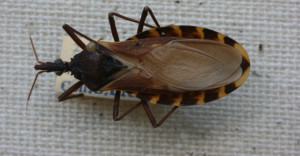Conenose, or kissing bugs (Triatoma sp.), are blood-feeding insects that are an occasional problem in Texas homes. Although conenose bugs bite humans and regularly transmit disease in parts of Latin America, for most U.S. victims the worst consequence is redness and itching at the site of the bite.
Identification
Conenose bugs are recognized by their elongated or “cone-shaped” head, prominent antennae, pear-shaped body, and spindly, stick-like legs. The body is black or dark brown, 1 to 3 cm (1 to 1 ½ inches) in length, with 12 orange spots ringing the outer edge of the abdomen. Long, beak-like mouthparts arise from the front of the head and are held under and against the center of the body when not in use.
Biology
Conenose bugs feed exclusively on the blood of vertebrate animals. Although generally rare, they are most common around animal nests or pet resting areas, emerging at night to search for blood meal. Their bites are gentle and painless, and usually occur while the victim is asleep. They are generally unable to bite through clothing. On humans, blood meals are sometimes taken from the tender areas of the face (hence the name “kissing bug”). Other sites of attack (in order of decreasing frequency) include the hands, arms, feet, head and trunk. Victims are frequently unaware of the bites until the following morning when unexplained reddened areas may be present on the skin of the arm or face.
Importance
Conenose bugs can be carriers of the protozoan parasite, Trypanosoma cruzi, that causes Chagas’ disease–a serious disease of humans that occurs most commonly from Mexico to South America. For many years very few human cases of Chagas’ disease were recorded in Texas (five cases since 1955); however recent attention by researchers appears to be turning up more human cases than previously thought possible (8 Texas-acquired cases in 2013, according to the Texas Department of State Health Services). Cases among dogs are more common (over 200 reported cases in 2013), especially in southern regions of Texas. While overall frequency of Chagas transmission to people in Texas is still relatively rare, people should be careful when handling bugs and should take steps to eliminate these bugs when found indoors.
Natural reservoirs of the Trypanosoma parasite are maintained in nature among small vertebrate animals, notably armadillo, opossums, rodents, bats, cats and dogs. Conenose bugs commonly feed on several different hosts during their development. Nymphs feed on an infected host and become infected themselves. The parasite can then be transmitted during subsequent blood meals to an un-infested host. While feeding, the insect may defecate on the skin of its victim. When a victim touches the feces, parasites may be transferred to the site of the bite, to the eye or to the mucous membranes around the mouth or nose. Transfer of the parasite may be hastened by scratching the bite. Chagas’ disease is difficult to diagnose, but is sometimes indicated in the initial stage by a swelling on one side of the face, known as the sign of Romaña.
Control
Conenose bugs are nocturnal and may be attracted to nighttime lights. In this way, solitary individuals may enter a home. A single conenose bug in the home is not necessarily cause for alarm. However the presence of nymphs (unwinged bugs) or numerous adult conenose bugs in your home suggested that a breeding population may be established nearby. Under these circumstances control may be justified.
Conenose bug infestations are likely to be more common in poorly constructed homes. Good sanitation and tight building construction tends to limit conenose bug infestations. Destroy trash piles, bird and animal nests and burrows. Control and exclude rodents and birds from the house. Seal exterior cracks and openings into buildings and keep chimney flues closed tightly. Inspect and seal any openings from crawl spaces into the house sub-flooring. Check pets for signs of feeding and examine pet houses.
Insecticides can effectively control conenose bugs. Treat room corners and edges, window and door frames, pet houses, and other suspected entry points with a pesticide labeled for these sites. Few household insecticides are labeled specifically for use against conenose bug; however products intended for indoor use against cockroaches or other indoor pests can be used. Look for products containing one of the pyrethroid insecticides: permethrin, bifenthrin, cyfluthrin, esfenvalerate or lambda cyhalothrin.
Consider using a licensed pest control professional for conenose bug control. Besides their experience in treating insect problems, professionals are better suited to assist you with control of possible rodent or pest bird problems. A professional can also point out ways to pest proof your home. The most effective professional products for conenose bug control include wettable powder or microencapsulated formulations of pyrethroid insecticides such as cypermethrin, lambda-cyhalothrin, deltamethrin, or cyfluthrin.
For more information
For more information about insect transmitted diseases in Texas, and how to submit specimens suspected of biting humans, contact the Texas Department of Health at (512)458-7111 or via Internet at https://www.dshs.texas.gov/IDCU/health/zoonosis/Triatomine-Testing.aspx. Texas A&M’s College of Veterinary Medicine and Biomedical Sciences is also conducting research on these insects. For more information on kissing bugs and how to confirm kissing bug identity, see https://kissingbug.tamu.edu/
The following references provide more information about Chagas’ disease and its insect vectors:
Ebling, Walter. 1975. Urban Entomology. University of California, Davis.
Goddard, Jerome. 1993. Physician’s Guide to Arthropods of Medical Importance. CRC Press, Boca Raton, FL.
Lent, H. and P. Wygodzinsky. 1979. Bulletin of the American Museum of Natural History. 163 (Art.3), 123.
Author
Michael Merchant, Ph.D., Urban Entomologist, Texas AgriLife Extension Service
